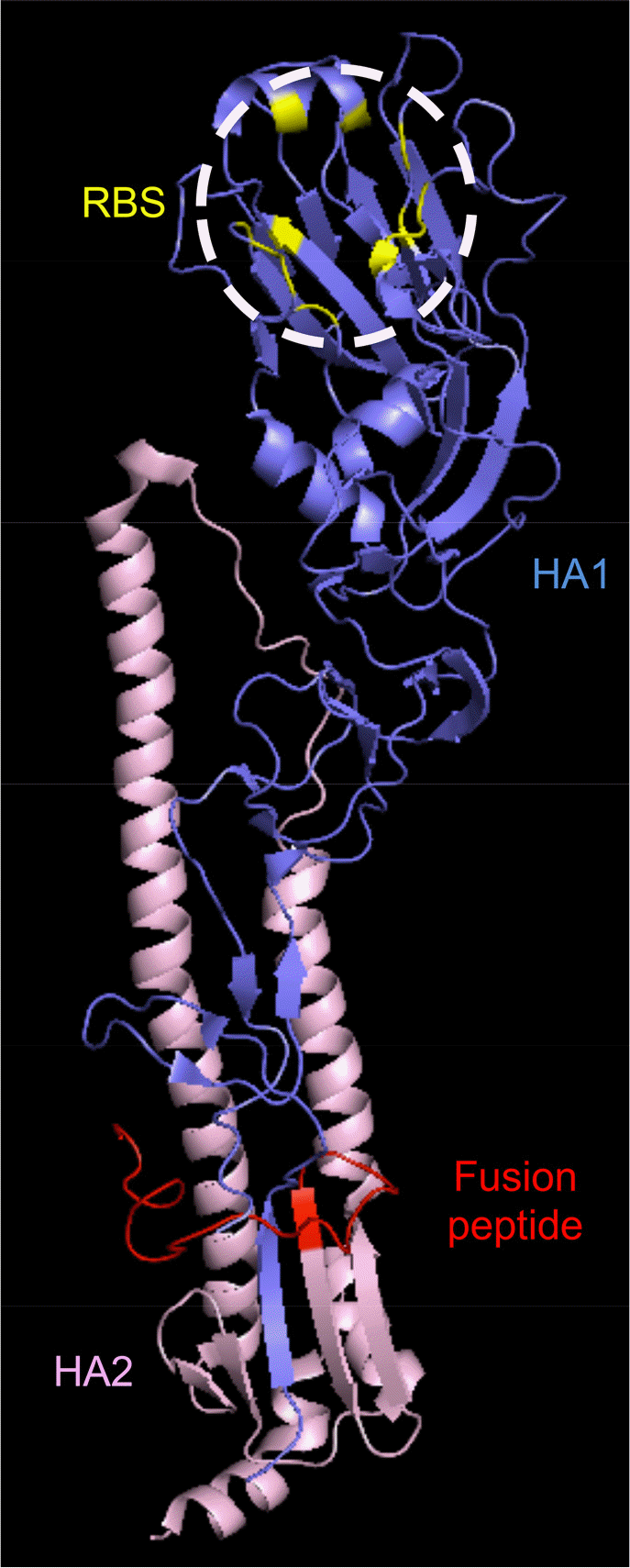Abstract
Influenza virus is a serious pathogen that burdens society with health care costs, and can lead to fatality. The virus is dealt with currently by vaccination and anti-influenza drugs. However, vaccines need to be improved towards safer and more efficient production formats, and drugs need to be constantly renewed to cope with resistances. That the neuraminidase inhibitors are only drugs currently available warrants urgent attention to an alternative anti-influenza target. In this paper we introduce studies on fusion activity of influenza virus hemagglutinin (HA), and discuss how to best utilize the knowledge for an improved vaccine development and an anti-influenza drug search. Potential application of mutations resulting in changes in fusion activity to cell culture optimized vaccine virus development and strategies to develop broad spectrum anti-influenza drugs through targeting the conserved fusion domain of the HA are discussed.
Go to : 
REFERENCES
1). Ye ZP, Pal R, Fox JW, Wagner RR. Functional and antigenic domains of the matrix (M1) protein of influenza A virus. J Virol. 1987; 61:239–46.

2). Tong S, Zhu X, Li Y, Shi M, Zhang J, Bourgeois M, et al. New world bats harbor diverse influenza a viruses. PLoS Pathog. 2013; 9:e1003657.

3). Park S, Kim JI, Park MS. Antiviral Agents Against Influenza Viruses. J Bacteriol Virol. 2012; 42:284–93.

4). Kim JI, Park S, Lee I, Lee S, Shin S, Won Y, et al. GFP-expressing influenza A virus for evaluation of the efficacy of antiviral agents. J Microbiol. 2012; 50:359–62.

5). Hamilton BS, Whittaker GR, Daniel S. Influenza virus-mediated membrane fusion: determinants of hemagglutinin fusogenic activity and experimental approaches for assessing virus fusion. Viruses. 2012; 4:1144–68.

6). Lee I, Kim JI, Park MS. Cell Culture-based Influenza Vaccines as Alternatives to Egg-based Vaccines. J Bacteriol Virol. 2013; 43:9–17.

7). Murakami S, Horimoto T, Ito M, Takano R, Katsura H, Shimojima M, et al. Enhanced growth of influenza vaccine seed viruses in vero cells mediated by broadening the optimal pH range for virus membrane fusion. J Virol. 2012; 86:1405–10.

8). Reed ML, Yen HL, DuBois RM, Bridges OA, Salomon R, Webster RG, et al. Amino acid residues in the fusion peptide pocket regulate the pH of activation of the H5N1 influenza virus hemagglutinin protein. J Virol. 2009; 83:3568–80.

9). Thoennes S, Li ZN, Lee BJ, Langley WA, Skehel JJ, Russell RJ, et al. Analysis of residues near the fusion peptide in the influenza hemagglutinin structure for roles in triggering membrane fusion. Virology. 2008; 370:403–14.

10). Park S, Kim JI, Lee I, Lee S, Hwang MW, Bae JY, et al. Susceptibility of human H3N2 influenza virus to oseltamivir in South Korea, 2009–2011. J Microbiol. 2012; 50:1067–70.

11). Kim JI, Park MS. An Universal Approach to Getting Ahead for Influenza B Vaccines. J Bacteriol Virol. 2012; 42:363–7.

12). Ekiert DC, Bhabha G, Elsliger MA, Friesen RH, Jongeneelen M, Throsby M, et al. Antibody Recognition of a Highly Conserved Influenza Virus Epitope. Science. 2009; 324:246–51.

13). Cao Z, Meng J, Li X, Wu R, Huang Y, He Y. The epitope and neutralization mechanism of AVFluIgG01, a broad-reactive human monoclonal antibody against H5N1 influenza virus. PLoS One. 2012; 7:e38126.

14). Dreyfus C, Laursen NS, Kwaks T, Zuijdgeest D, Khayat R, Ekiert DC, et al. Highly conserved protective epitopes on influenza B viruses. Science. 2012; 337:1343–8.

15). Ekiert DC, Wilson IA. Broadly neutralizing antibodies against influenza virus and prospects for universal therapies. Curr Opin Virol. 2012; 2:134–41.

16). Oh HL, Akerström S, Shen S, Bereczky S, Karlberg H, Klingström J, et al. An antibody against a novel and conserved epitope in the hemagglutinin 1 subunit neutralizes numerous H5N1 influenza viruses. J Virol. 2010; 84:8275–86.

17). Fleishman SJ, Whitehead TA, Ekiert DC, Dreyfus C, Corn JE, Strauch EM, et al. Computational design of proteins targeting the conserved stem region of influenza hemagglutinin. Science. 2011; 332:816–21.

18). Brancato V, Peduto A, Wharton S, Martin S, More V, Di Mola A, et al. Design of inhibitors of influenza virus membrane fusion: synthesis, structure-activity relationship and in vitro antiviral activity of a novel indole series. Antiviral Res. 2013; 99:125–35.
19). Brooks MJ, Burtseva EI, Ellery PJ, Marsh GA, Lew AM, Slepushkin AN, et al. Antiviral activity of arbidol, a broad-spectrum drug for use against respiratory viruses, varies according to test conditions. J Med Virol. 2012; 84:170–81.

20). Leneva IA, Russell RJ, Boriskin YS, Hay AJ. Characteristics of arbidol-resistant mutants of influenza virus: implications for the mechanism of anti-influenza action of arbidol. Antiviral Res. 2009; 81:132–40.

21). Russell RJ, Kerry PS, Stevens DJ, Steinhauer DA, Martin SR, Gamblin SJ, et al. Structure of influenza hemagglutinin in complex with an inhibitor of membrane fusion. Proc Natl Acad Sci U S A. 2008; 105:17736–41.
Go to : 
 | Figure 1.
Structure of influenza hemagglutinin. Three-dimensional structure of influenza HA protein was represented using that of A/California/04/2009 (PDB ID: 3LZG) in a PyMOL software. HA domains and regions were specified by colors: slate blue, HA1; light pink, HA2; yellow, receptor binding site (RBS); and red, fusion peptide. |
Table 1.
Amino acids required for enhancing membrane fusion activity
| HA region | Residue | Amino acids | Referencea |
|---|---|---|---|
| HA1 | 17 | Y | (9) |
| HA2 | 109 | D | (9) |
| HA2 | 111 | T | (9) |
| HA2 | 114 | N | (8) |
| HA2 | 117 | N | (7) |




 PDF
PDF ePub
ePub Citation
Citation Print
Print


 XML Download
XML Download